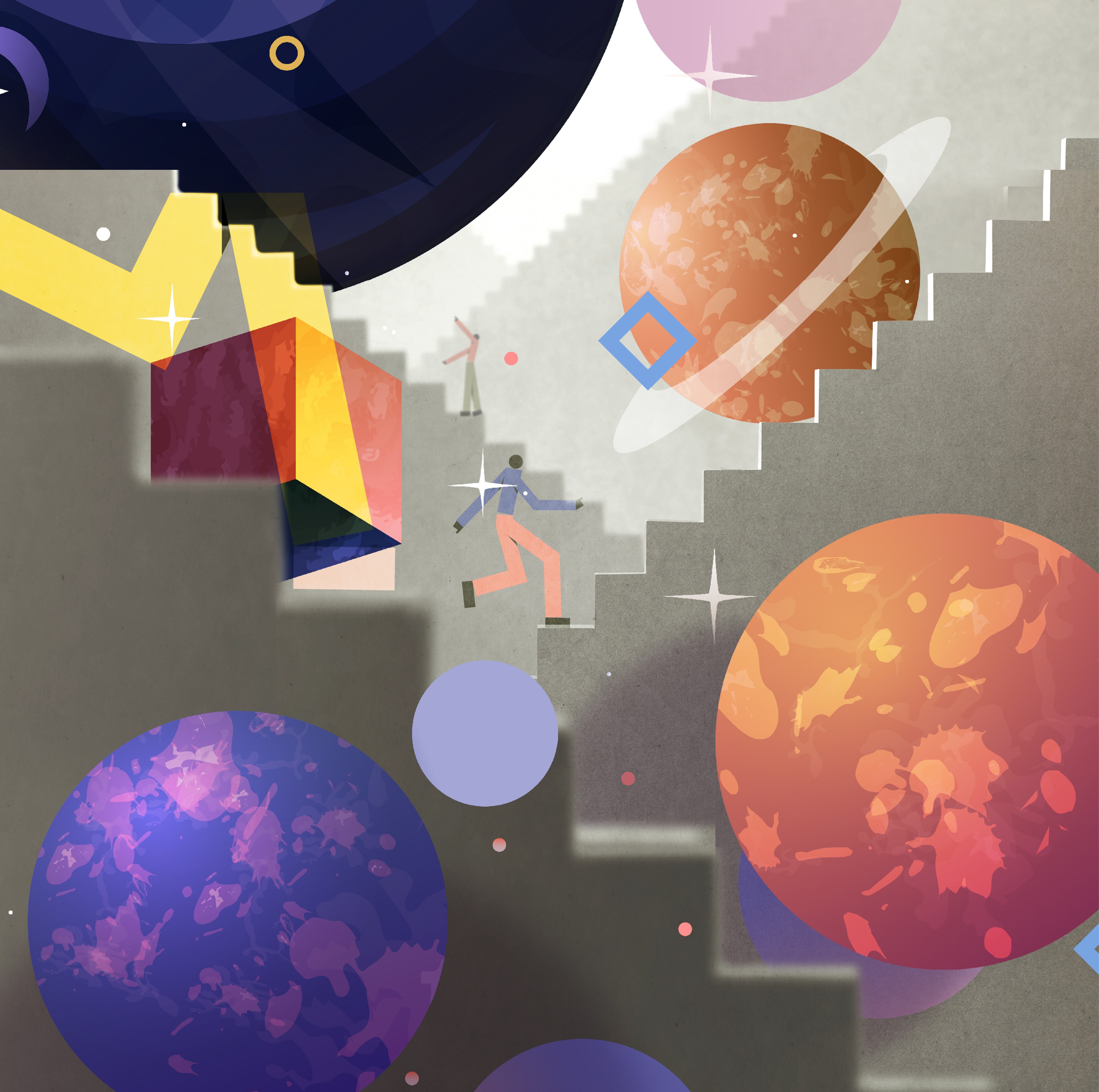Boundaries and Resonance of the Body

- Date: April 26, 2024
- Location: Zhejiang University
Does the body have boundaries? What are the boundaries of the body? How would you define "body"?
What is resonance? What is a body with resonance? And how does resonance inspire life nourishment?
The dialogue will commence with reflections on embodiment. In the morning session, Wang will facilitate a contemplative retreat at Zhejiang University’s Zhijiang Campus, before the group reconvene in the afternoon to delve into Lai's exploration of "the multiplicity of bodies" and Wang's research on "resonance and vitality," engaging the audience in discussions on the boundaries of embodiment and resonance. Together, we will explore the intersecting realms of embodiment and resonance.
This is the first event that the Berggruen Research Center at Peking University collaborates with the Institute for Advanced Study in Humanities and Social Sciences at Zhejiang University.
About the speakers:
Adel-Jing Wang
Associate Professor of Sound Studies, Zhejiang University
2023 - 2024 Berggruen Institute China Fellow
Based in Hangzhou, China, Adel-Jing Wang is a sound studies scholar, art anthropologist, curator and practitioner in sound art. She is currently an associate professor of sound studies at Zhejiang University, China and has also served as a visiting scholar at MIT Anthropology(2019-2020) and the School of Creative Media at City University of Hong Kong (2017.2). She is the artist in residence at The Swiss Arts Council Pro Helvetia (2022-2023) and founded the Sound Lab at the College of Media and International Culture at Zhejiang University (2015-2021). Wang is also the author of the books Half Sound, Half Philosophy: Aesthetics, Politics, and History of China‘s Sound Art (Bloomsbury, 2021, English language) and Sound and Affect: An Anthropology of China’s Sound Practice (2017,Chinese language). In her artistic practice, Wang works with field recordings, voice, and installation-based performance. She considers research and art practice as mutually-enriching exercises producing concepts for further exploration.
LAI Lili
Associate Professor of Anthropology, Peking University
2023 - 2024 Berggruen Institute China Fellow
Lai is an Associate Professor of Anthropology at the School of Health Humanities at Peking University. She received her MA and PhD in Anthropology from UNC-Chapel Hill. She has done extensive ethnographic and interdisciplinary research on health-related issues in rural and urban communities of Northern and Southwestern China.
Event Summary
On the afternoon of April 26, 2024, Berggruen Fellows LAI Lili and WANG Jing held a joint-dialogue at the Institute for Advanced Humanistic Studies at Zhejiang University. The dialogue centered on the theme “The Boundaries and Resonance of the Body.” Lai Lili, an associate professor at the School of Health Humanities at Peking University, focuses her research on the body, medical practices, and the practical aspects of everyday life. Her work examines cutting-edge medical technologies and traditional medical knowledge systems through the lens of cultural anthropology. Wang Jing, an associate professor at the College of Media and International Culture in Zhejiang University, specializes in sound and sensory studies, as well as the anthropology of art. In 2015, Wang founded the “Sound Lab” at Zhejiang University, dedicated to fostering interdisciplinary sound experiment projects. The dialogue was moderated by Liu Liu, an associate professor at the College of Dance at the Minzu University of China.
In the morning, under Wang’s guidance, scholars and guests engaged in a practice of silent listening in the dense forest of Zhejiang University’s Zhijiang Campus. This practice involved following continuous and repetitive sounds in the environment—whether geographic, natural, or human-made—to experience the rhythm of the surroundings. Following this meditative activity, the participants moved to the third-floor lecture hall of the Bell Tower to take part in the dialogue.

Resonance and the Nourishment of Life
Wang began with a discussion of the avant-garde art movements of 1960s America, introducing the concept of “Deep Listening” coined by American experimental musician Pauline Oliveros (1932–2016). Deep Listening, as Oliveros defined it, is “listening in every possible way to everything possible to hear no matter what you are doing.” This practice encompasses all kinds of sounds—those of daily life, nature, personal thoughts, and music—cultivating an awareness of and connection with the manifold forms of existence. Through Deep Listening exercises, the practitioner comes to understand that the body acts before consciousness, even if this difference is only a fraction of a second in neuroscientific terms.
Wang extended the exploration of Deep Listening to the theory of electronic and acoustic music. The political stance of such music emphasizes everyday practices, breaking away from the rigorous training required for classical music instruments. Electronic-acoustic music does not require specific venues, equipment, formal organization, or even an audience. The street is as good a place as any for a performance. In this sense, the performance of electronic-acoustic music is not for others but for oneself. Wang noted that although the common form of electronic-acoustic music is avant-garde, its values are classical—perhaps not classical in the way it is typically construed, but in the Daoist sense of “nourishing life” or “feeding life to life.” In this regard, her research examines how seemingly avant-garde and technology-dependent art forms, such as improvisational music in electronic-acoustic performance, can serve as intellectual resources for the nourishment of life.

In the context of Deep Listening, the environment plays a crucial role, as electronic-acoustic and improvisational music invites a rethinking of what constitutes an “environment” to begin with. The inspiration for Deep Listening itself came from a specific space: a concrete underground cistern discovered by Stuart Dempster, Pauline Oliveros, and Panaiotis. With a reverb time of 45 seconds, the cistern naturally invited improvisational performance. The album recorded there was named “Deep Listening”—the term “deep” referring not only to the physical depth of the space but also to the profound nature of the improvisational performance. Similarly, Alvin Lucier’s “I Am Sitting in a Room” is a piece that uses the inherent frequencies of space and human voice as core elements of musical creation. In this work, the space’s resonant frequencies become more prominent as the intelligibility of the language gradually fades, transforming the medium of language into a progressively sonic environment.
What, then, is the “environment”? Does it refer to the modern, often scientific, connotation of environment or to the more classical idea of “Heaven”? The classical Daoist notion of “the unity of Heaven and humanity” describes a process of continuous interaction between humans and the cosmos. ZHANG Zai defined Tian as an extraordinarily complex and harmonious process of qi (vital energy). Through Zhang Zai’s philosophy of qi, it becomes clear that humans, as one of the myriad things in the universe, are interconnected with animals, plants, and even inorganic entities like stones and sand, forming an organic web of life. Nothing exists in isolation (“things do not exist in isolation”). Everything thrives through reciprocal contraction and extension.
Two British anthropologists, Gregory Bateson (1904-1980) and Tim Ingold (1948-), share a similar sentiment with Zhang Zai. Bateson posed the question: “What sort of thing is this, which we call organism plus environment?” He rejected Darwinian natural selection and evolution, arguing that the unit of survival is not the genetically fittest organism but the organism in addition to its environment. Ingold built on Bateson’s ideas, asserting that “organism plus environment” still implies a separation, whereas, in reality, there is no organism without the environment. In understanding this, Pauline Oliveros often incorporated weather and natural surroundings into her improvisational performances, adapting to external environmental changes and seeking to form a unity within them.
Wang Jing emphasized that Deep Listening is not analytical but “resonant,” proposing the use of “resonance” as a new cognitive framework. Anthropologist Steven Feld coined the term “acoustemology” (a fusion of “acoustics” and “epistemology”). This neologism attempts to expand sound-based methods of knowing, treating sound as a medium for transmitting cultural knowledge. In the 1970s, Feld began conducting fieldwork among the Kaluli people of the Bosavi rainforest in Papua New Guinea, documenting how they understand and share their acoustic knowledge. Tom Rice, a cultural anthropologist of sound, referred to this as “conspicuous acoustemology,” while Wang contrasted it with what she called “inconspicuous acoustemology,” which she translated into Chinese as “默契” (moqi). In Chinese, mo means quiet or silent, while qi signifies agreement, friendship, or a bond. The ancient character for qi depicts two hands joining together. Though different, the hands maintain a subtle harmony. In this sense, “inconspicuous acoustemology” describes a nurturing rather than a consumptive ecological relationship—a cognitive process that is deeply felt yet difficult to articulate.
What principles, then, do improvisational performance and the nourishment of life share? The first is “getting back to basics.” The second is “following and nurturing”—helping sound become sound and life become life. This, in many ways, recalls the Daoist metaphor of the butcher’s knife in Zhuangzi, which carves without resistance, allowing the outcome to unfold naturally and with minimal energy. This logic is neither constructivist nor postmodern but continuous and infinitely renewing. For Zhang Zai, the capacity for resonance with the cosmos and all things is one of humanity’s primary goals, though this capacity is often obscured. Resonance, the process of continuous unfolding, is the very ability to give life to life. For Zhang Zai, resonance is therefore a key aspect of creativity: “Through resonance, that which penetrates and connects becomes sincerity.”

The Boundaries of the Body
Following Wang Jing’s remarks, Lai Lili explored the concept of “the boundaries of the body.” We naturally assume our skin to be the limit of our bodies, but, drawing on the morning’s listening experience, Lai posed the question: when walking ten times slower across the Lovers’ Bridge, why do our movements become unconsciously influenced by the group? Where, then, are the boundaries of the body?
The first question in discussing bodily boundaries is how to understand the individual and the self. If the self is indivisible, why do we change? Conversely, if we adopt the Daoist notion of “the unity of Heaven and humanity,” where the body and the external world are inherently interconnected and constantly exchanging, where does the body end? On the Lovers’ Bridge, the group seemed to act as one entity, yet individual differences remained.
Medical historian Nathan Sivin described the body as an “ensemble of processes.” In traditional Chinese medicine, the body comprises interconnected systems—meridians, organs, and qi-blood flows—engaged in continuous activity. Similarly, in Western medicine, the process of metabolism involves constant exchange with the external world. Deleuze described the body as an “assemblage,” while Sivin terms it an “ensemble.” Both categorizations emphasize the processual and composite nature of the body, which functions like a device, simultaneously aggregating and exchanging its components. Boundaries, while not absent, are relatively fluid.
Returning to the morning’s listening exercise, Lai noted that breathing can alter our state of mind, breaking bodily boundaries. If breathwork and physical exercise can transcend these boundaries, why can’t the technologies of electronic-acoustic music do the same? Improvisational techniques already challenge conventional assumptions about the body’s limits.
Yet, if we are able to transcend the boundaries of the body, why do we remain distinct individuals? This is because a person’s history, experiences, and social relationships are inscribed within the body, continuously shaping it. Exploring bodily boundaries is ultimately a way to rethink individuality. Are we indivisible selves, or are we beings that exist in interdependence with our surroundings? The “environment” here is not merely nature but a unification of the internal and external, embodying the Daoist idea of “the unity of Heaven and humanity.”
Reflecting on her listening experience, Lai described standing by a pavilion overlooking the Qiantang River. She unconsciously uttered the sound “ha,” which arose not from her mind but from resonance with the people, trees, and river around her. Sensation, she reflected, is not self-directed but emerges from interaction. The body is not entirely self-contained—the very act of sensing breaks boundaries.
If bodily boundaries are already being transcended, does technology pose a threat? The universe is constantly transforming; change is constant and inevitable. If we view humans as immutable entities, technology might seem invasive. But if we see the body as open and adaptive, our understanding of technology changes. This perspective does not necessitate passively waiting for technology to break our boundaries but engaging in co-evolution, forming a dynamic flow that enables new modes of existence. These modes are not strictly biological or natural but are mediated by technology. The concept of the “post-human” envisions humans as continually adjusting to their surroundings, aware of both their boundaries and potential.
The emergence of AI provides an opportunity to rethink the body, opening it to new relationships with the world. Is sensation located only in the brain? Many technologies are developing in this direction, but the body can never truly be abandoned or transcended. If we are to discuss life, how can we separate it from the body?
---
Summary drafted by Berggruen Intern QIU Shuyi




















